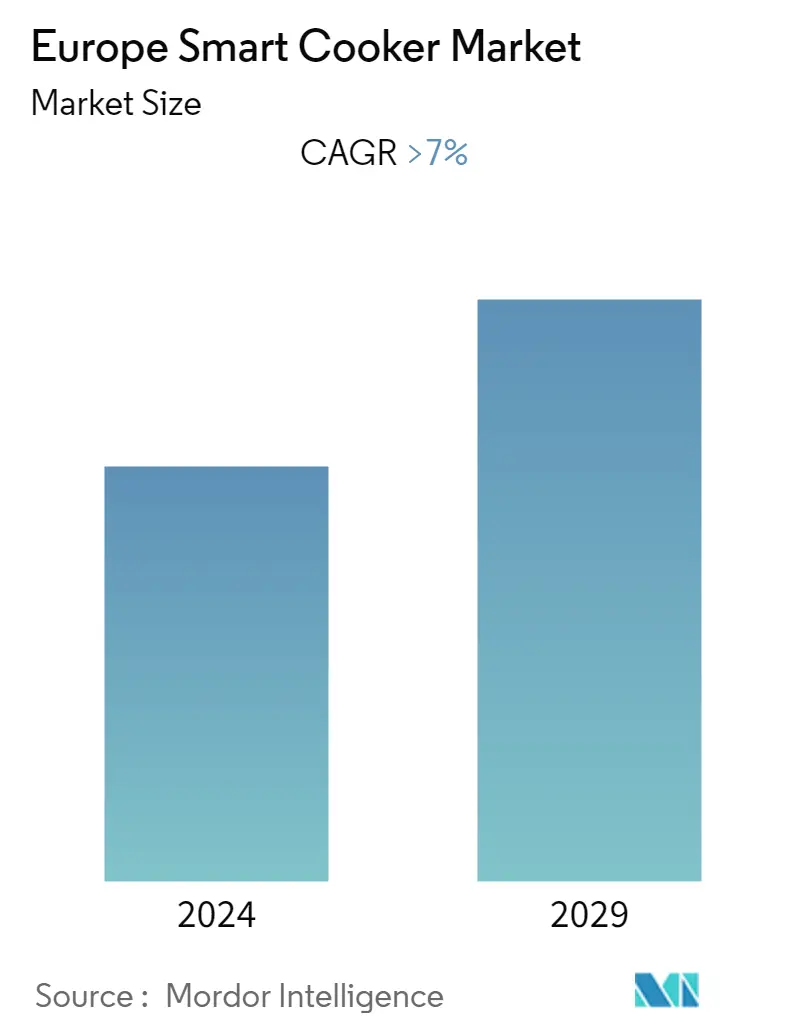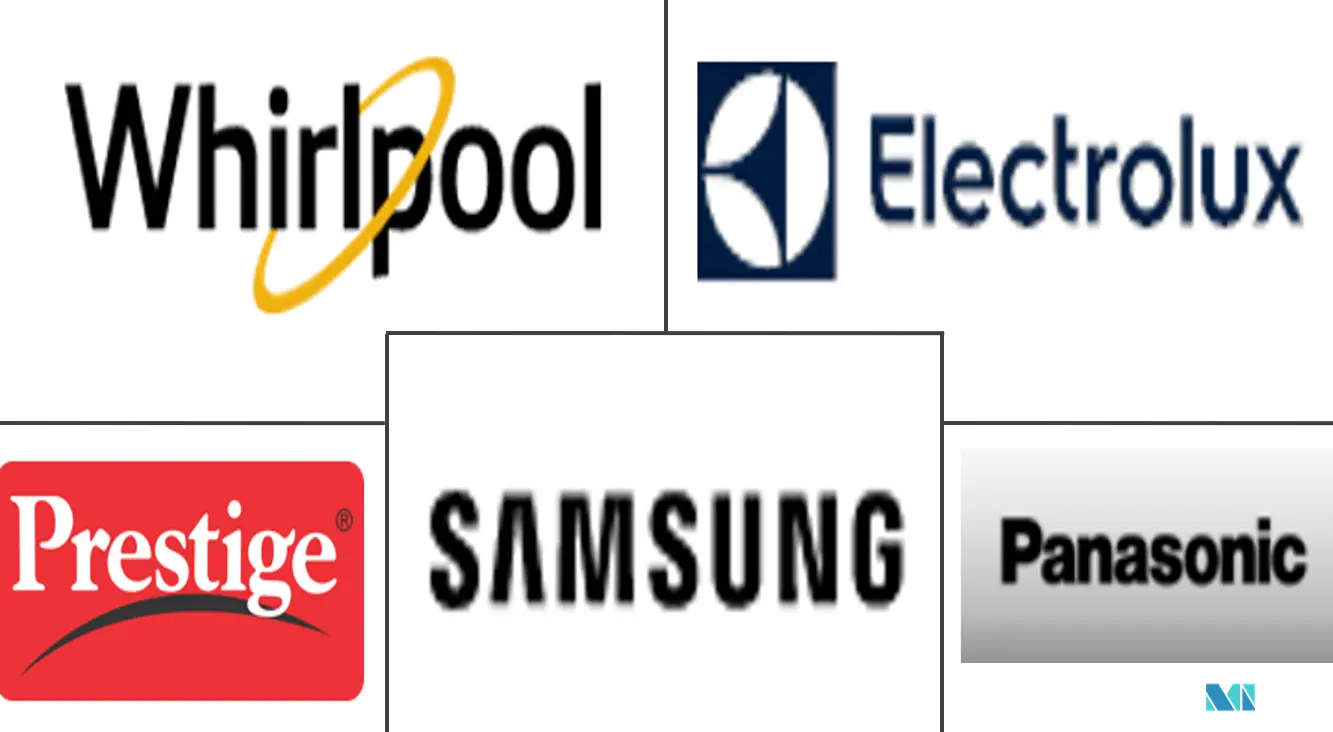Market Size of Europe Smart Cooker Industry

| Study Period | 2020 - 2029 |
| Base Year For Estimation | 2023 |
| Forecast Data Period | 2024 - 2029 |
| Historical Data Period | 2020 - 2022 |
| CAGR | > 7.00 % |
| Market Concentration | Medium |
Major Players
*Disclaimer: Major Players sorted in no particular order |
Europe Smart Cooker Market Analysis
Europe Smart Cooker Market is poised to grow at a CAGR of 7% during the forecast period.
Sales prospects of smart cookers were largely unaffected by COVID-19. Despite the rigorous implementation of prohibitions on industrial and logistical operations, growth was observed in the market in 2019. At the peak of the pandemic, consumers' growing concerns for the environment encouraged them to spend money on efficient and intelligent equipment, leading to the purchase of smart cookers.
IoT-enabled appliances known as "smart cookers" are largely used in household and hospitality kitchens. Users can now remotely operate and control smart appliances and devices using smartphones and tablets owing to the integration of Bluetooth and Wi-Fi. With a primary focus on increasing efficiency in the kitchen and minimizing the time spent cleaning and cooking, the adoption of smart homes has substantially altered the kitchen scene.
Cookers are frequently used by people to meet their daily food needs. The demand for such products is primarily influenced by pot capacity, design material, and cooking time. Modern hotel chefs and housekeepers are turning to multifunctional kitchen appliances to prepare meals quickly. As a result, well-known manufacturers are concentrating on providing multifunctional gadgets to fulfill these diverse client needs.
Europe Smart Cooker Industry Segmentation
People regularly use cookware to fulfill their everyday cooking needs. The cooking time, design material, and pot capacity impact consumer demand for smart cookware products. Smart kitchen appliances are more expensive than conventional kitchen equipment. However, they are more effective and time-saving. The European smart cooker market is segmented by capacity type (small (less than 3qt), medium (more than3.1qt - 6qt), large (more than 6.1qt)), distribution channel (online, offline), and geography (Germany, Netherlands, United Kingdom, Italy, and Rest of Europe). The report offers market size and forecasts for European Smart Cooker Market in value (USD Million) for all the above segments.
| By Capacity Type | |
| Small (Less Than 3qt) | |
| Medium (More Than3.1qt - 6qt) | |
| Large (More Than 6.1qt) |
| By Distribution Channel | |
| Online | |
| Offline |
| By Geography | |
| Italy | |
| Netherlands | |
| Germany | |
| United Kingdom | |
| Rest of Europe |
Europe Smart Cooker Market Size Summary
The European smart cooker market is experiencing a robust growth trajectory, driven by the increasing integration of IoT technologies in kitchen appliances. These smart cookers, which can be controlled remotely via smartphones and tablets, are becoming essential in both household and hospitality settings. The shift towards smart homes has significantly transformed kitchen dynamics, emphasizing efficiency and convenience. The demand for smart cookers is influenced by factors such as pot capacity, design material, and cooking time, with multifunctional appliances gaining popularity among modern chefs and home cooks. The market's resilience during the COVID-19 pandemic highlighted consumers' preference for energy-efficient and intelligent cooking solutions, further propelling market expansion.
Rapid urbanization and the fast-paced lifestyles of European consumers are contributing to the increasing adoption of smart kitchen appliances. The growing awareness of healthy eating habits, particularly during the pandemic, has also boosted market revenue. Technological advancements, including NFC and Wi-Fi capabilities, are enhancing the functionality of these appliances, allowing for features like preheating and temperature regulation to be controlled remotely. The market is characterized by the presence of major players such as Samsung Electronics, Whirlpool, and Panasonic, while mid-size and smaller companies are expanding their presence through technological innovations and new market entries. Recent product launches, like Prestige's multi-cooker and Panasonic's portable cooker, underscore the ongoing innovation and diversification within the market.
Europe Smart Cooker Market Size - Table of Contents
-
1. MARKET DYNAMICS AND INSIGHTS
-
1.1 Market Overview
-
1.2 Market Drivers
-
1.3 Market Restraints
-
1.4 Industry Attractiveness - Porter's Five Forces Analysis
-
1.5 Value Chain Analysis
-
1.6 Insights on Current Trends and Recent Developments
-
1.7 Insights on Technological Advancements and Innovations
-
1.8 Impact of COVID-19 on the Market
-
-
2. MARKET SEGMENTATION
-
2.1 By Capacity Type
-
2.1.1 Small (Less Than 3qt)
-
2.1.2 Medium (More Than3.1qt - 6qt)
-
2.1.3 Large (More Than 6.1qt)
-
-
2.2 By Distribution Channel
-
2.2.1 Online
-
2.2.2 Offline
-
-
2.3 By Geography
-
2.3.1 Italy
-
2.3.2 Netherlands
-
2.3.3 Germany
-
2.3.4 United Kingdom
-
2.3.5 Rest of Europe
-
-
Europe Smart Cooker Market Size FAQs
What is the current Europe Smart Cooker Market size?
The Europe Smart Cooker Market is projected to register a CAGR of greater than 7% during the forecast period (2024-2029)
Who are the key players in Europe Smart Cooker Market?
Samsung Electronics Co. Ltd, Whirlpool Corporation, Panasonic Corporation, Electrolux AB and Prestige are the major companies operating in the Europe Smart Cooker Market.

